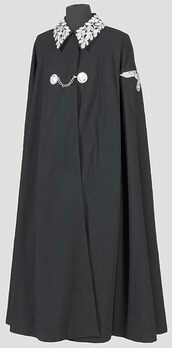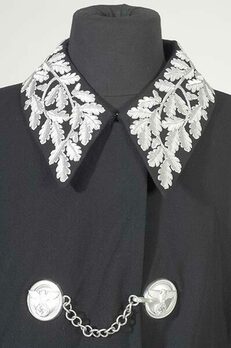Diplomatic Corps Rome State Visit Cape
SKU: 34.GOR.02.01.04.001
Estimated market value:


Estimated market value:
Attributes
History
The Diplomatic Corps was made up of officials (civil servants) of the Foreign Ministry. This ministry was taken over in 1938 by newly appointed Foreign Minister Joachim von Ribbentrop who, for the first time, introduced specific Diplomatic Corps uniforms. Prior to 1938, there had been no defined uniforms for members of the Foreign Office.
Prior to the war, the Foreign Ministry was heavily involved in the annexation of Austria and the Sudetenland. During the war, some conquered territory, especially in Poland, was incorporated into the German Reich, while other territory was merely occupied. These countries, while officially still independent, were in reality administered by German officials of the Diplomatic Corps, and in some cases also German-approved puppet governments.
It is important to remember that the officials who served within the borders of the German Reich weren’t of course part of the Foreign Ministry, but rather of the Ministry of the Interior. However, the officials of both these ministries wore nearly identical uniforms.
Officials of the Diplomatic Corps were distinguished by rank as well as their educational level. The latter determined which kind of “Laufbahn” (career) an individual was able to choose. The “Höherer Dienst” (Higher Career) required a university degree, the “Gehobener Dienst” (Elevated Career) required a college degree, the “Mittlerer Dienst” (Middle Career) required a highschool degree, and the “Einfacher Dienst” (Lower Career) required a grade school education, to put it in a simplified way. Additionally, the Higher and Elevated Careers included several different pay groups.
Uniforms for the Diplomatic Corps were first introduced in 1938. They underwent near continuous modification between then and 1943.
The first uniforms specifically designed for members of the Diplomatic Corps were made for Hitler’s state visit to Rome in May of 1938. These uniforms were only worn by those members of the Diplomatic Corps who were part of his entourage during the visit. They were not worn again after this occasion.
The cape was worn as part of the evening dress uniform in lieu of the greatcoat. It was made of midnight-blue cloth that looked almost black and has silver-coloured collar piping and a hand-embroidered oak leaf pattern which depended on the wearer’s pay group. There are three ways to close the cape at the front, either by means of concealed buttons, by a hook-and-eye closure at the collar, or by a chain worn at chest level connected to two round silver-coloured buttons featuring the national eagle emblem and a rope-like pattern.
The interior of the cape is lined with black silk. The cape has no provisions for arm openings. It was worn with a sleeve eagle.


Comments
Sign in to comment and reply.


Scroll Top